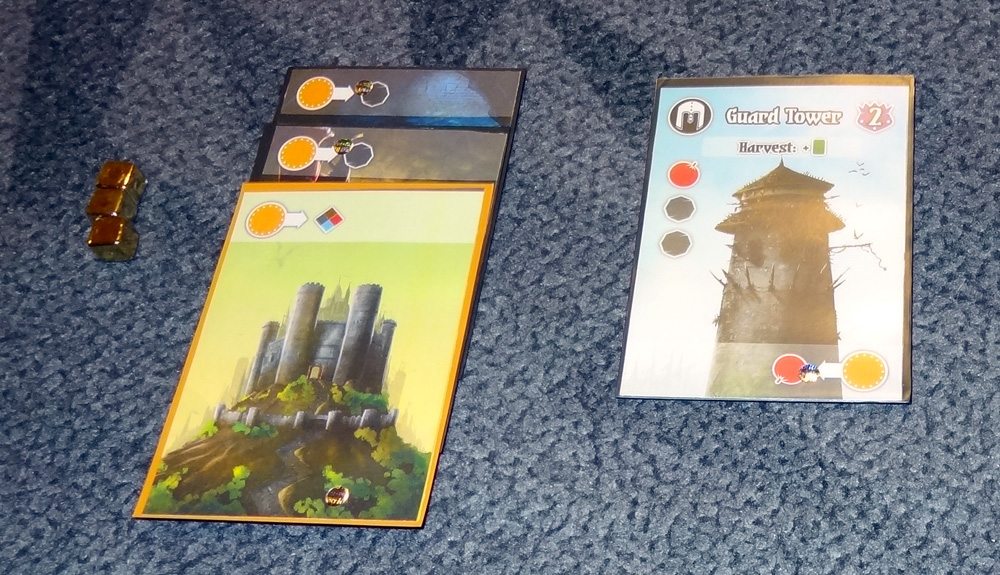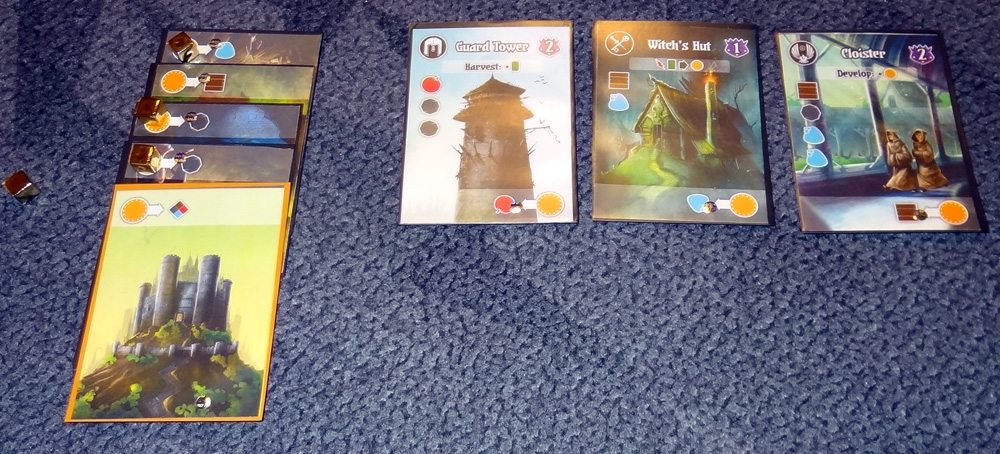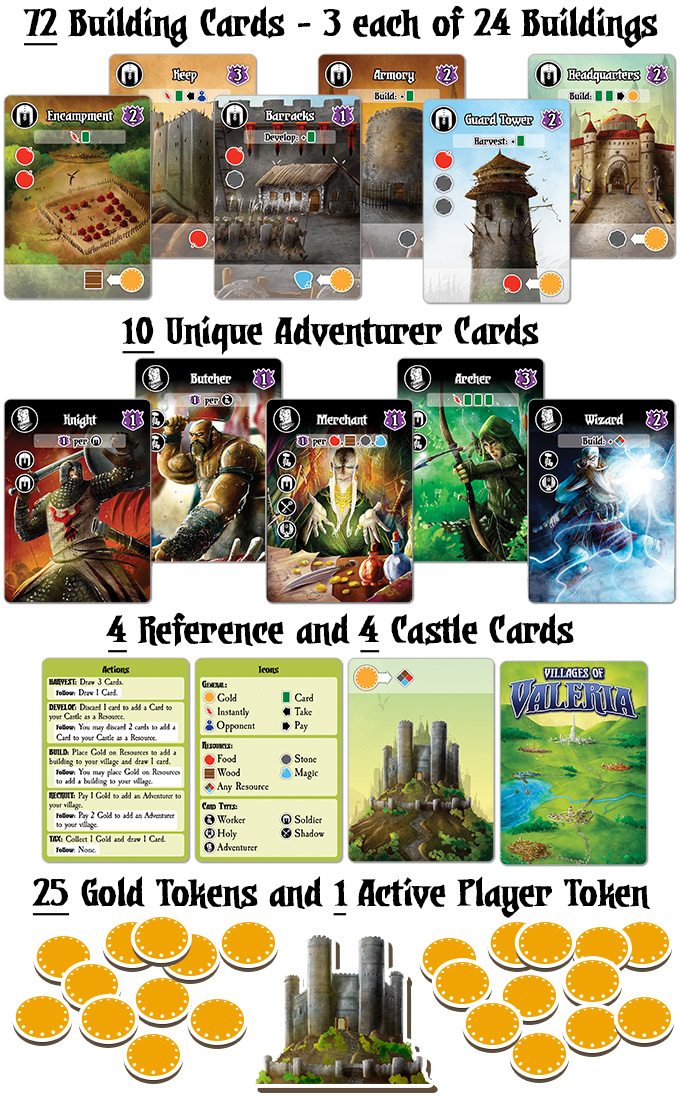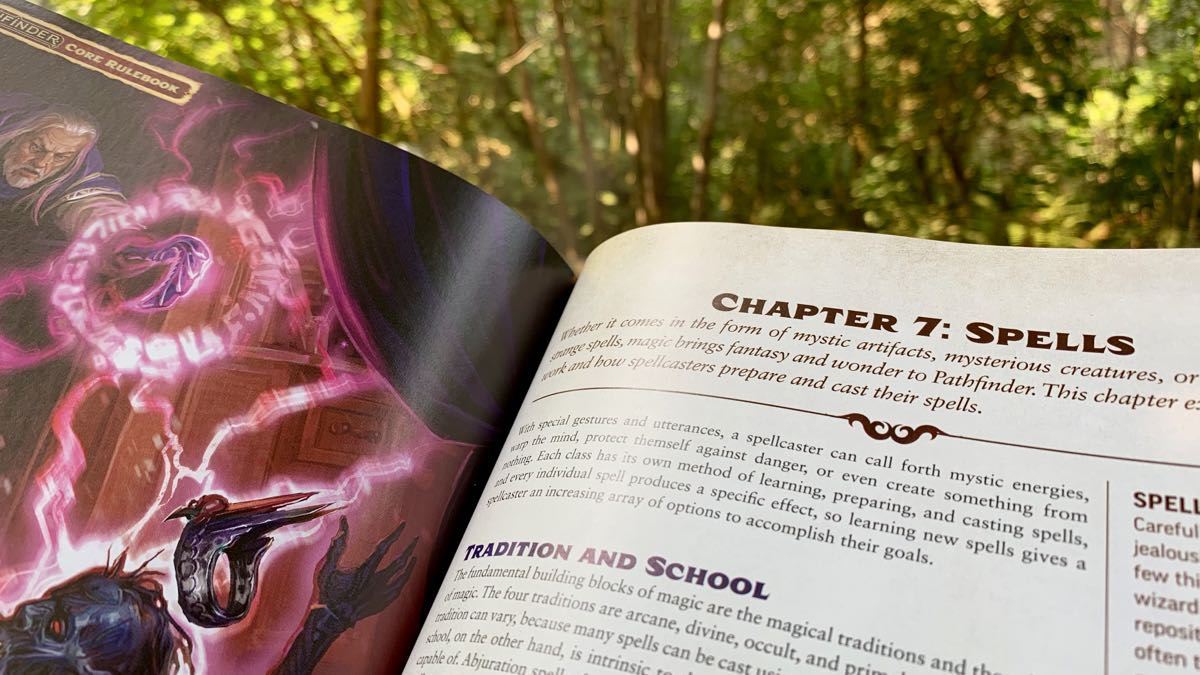You are a Duke, vying to become the capital city in the land of Valeria. Build up resources, construct buildings, and recruit adventurers. And pay no attention the hordes of monsters that are approaching… they arrive in the sequel.
At a glance: Villages of Valeria is a game by Daily Magic Games for 2 to 4 players, ages 14 and up, and takes about 30 minutes to play. It’s currently seeking funding on Kickstarter, with a pledge of $19 for a copy of the game (or $8 for a full-art Print and Play). Although the artwork for the adventurers can be a little intense, I don’t think there’s anything inappropriate for younger players, and I would say you could probably play this with kids as young as 10 or 12, depending on their level of experience.
New to Kickstarter? Check out our crowdfunding primer.
Components:
- 72 Building cards (3 each of 24 buildings)
- 10 Adventurer cards
- 4 Castle cards
- 4 Reference cards
- 25 gold coins
- 1 Active Player token
The components list is subject to change based on stretch goals–for instance, there may be additional Buildings and Adventurers, the gold coins may be upgraded from cardboard tokens to wooden tokens, and so forth. However, the list above reflects the guaranteed components if the game funds. In addition, Kickstarter backers will get one additional bonus Adventurer card, the Baron.
The game is set in the same world as Valeria: Card Kingdoms, and the artwork is again from The Mico, so some of the Adventurers (at least as they are currently) may look familiar from that game. The prototype set I used for a demo had finished artwork but not final component quality, though based on the finished copy of V:CK, I would say you can count on nice components for this one as well.
How to Play
You can download a copy of the rules here, as well as a Print and Play version if you’d like to try it yourself. Finally, if you have Tabletop Simulator, you can try Villages of Valeria in digital form.
The goal of the game is to have the most Victory Points in Buildings and Adventurers by the end of the game.

To set up, give each player a Castle card, a Reference card, and 3 gold coins. Shuffle the Building cards and deal 6 to each player. Turn 5 Building cards face-up on the table and set the deck nearby. Shuffle the Adventurer deck, turn 5 face-up and put 5 face-down in a stack, and then return any unused Adventurers back to the box. Give the active player marker to the first player. Each player, in turn order, chooses a card from their hand to develop as a resource, tucking it upside-down under their Castle so the resource is visible at the top. Now the game is ready to begin.
During each turn, the active player will first recover any gold that is on their resource cards and the Castle. Then, the active player will choose an action, and then all the other players have an opportunity to follow that same action, but at a lower level. Then the active player token passes to the next player, and the next turn begins.

Here are the available actions (and the follow actions):
- Harvest: Draw 3 cards. (Follow: Draw 1 card.)
- Develop: Discard 1 card, and then put a card under your Castle as a resource. (Follow: Discard 2 cards to develop a resource.)
- Build: Pay the cost of a Building to build it, and draw a card. (Follow: Pay the cost of a building to build it.)
- Recruit: Pay 1 gold to recruit an Adventurer. (Follow: Pay 2 gold to recruit.)
- Tax: Draw 1 card and take 1 gold from the supply. (Follow: No action.)
When you draw Building cards, you may draw the top card from any of the 5 face-up pools, or from the face-down deck. Face-up pools are replenished from the deck as soon as they are empty. When you discard cards, they are discarded into any of the pools of your choice.

To pay for a Building, you must buy one of each resource shown on the Building card. You place gold coins on the resource cards to buy them; your Castle can provide a wild resource of your choice. You may only place gold on resources that don’t already have gold on them. However, you may use resources belonging to other players–but then the gold belongs to them.
When you recruit Adventurers, you must have the building types shown on the Adventurer card as a prerequisite. The gold is paid to the supply.
Most Buildings and Adventurers have abilities of some sort. Some are instant abilities (marked with a lightning bolt) and give you an immediate, one-time effect. Others are tied to specific actions; for instance, you might get to draw an extra card every time you take the tax action, or get a free wood every time you build.
The game ends when any player reaches the target number of cards (Buildings and Adventurers, not counting resources): 10 for a 4-player game, 12 for a 3-player game, and 14 for a 2-player game. Add up all the scores for your Buildings and Adventurers, plus any bonus scores awarded by them. Highest score wins!
The Verdict
In March last year, I wrote about a Kickstarter for Valeria: Card Kingdoms, a game that reminded me a little bit of Machi Koro but with its own unique spin on it. The campaign was successful, and the finished game was delivered to backers last month. Daily Magic Games has plans to develop more stand-alone games set in Valeria, and this is the next game in the series–technically it’s a prequel, as it takes place before the hordes of monsters invade Valeria.
I’m not actually sure what genre to call this game. There’s resource management, and card effects, action selection… bits and pieces of it remind me of one game or another, but put it together and it’s hard to categorize. I’ve seen the phrase “tableau-building” and that may be the best fit, putting it in a similar category as Valeria: Card Kingdoms and Imperial Settlers, for instance. In each of these games, you collect cards that fill out your tableau, award you points but also giving you abilities that will then be used to add more cards to the tableau.
Regardless of what you call it, though, Villages of Valeria is fun and engaging. It’s not too difficult to teach, and it’s satisfying for players who like to build up cities and economic engines. Here, you have to decide how to use your limited resources (gold and cards) in order to fill out your tableau with the most points.
Often, you have to choose between the short-term and the long-term benefits, or between scoring points or getting more resources. For example, some cards give instant benefits–it’s hard to pass up something that will immediately give you more cards or gold. On the other hand, if you invest early in a building that gives you a free resource every time you build, that can pay off immensely.
I like the fact that the building cards are used in several ways: you can build them as buildings, develop them as resources, or discard them to pay for development. You’ll look at your hand and want to build all of them as buildings because of the cool abilities, but you know you’ll have to use some as resources and some will just get discarded.
I also thought it was fascinating that you can spend your gold on other players’ resources. That’s something I haven’t seen often. If you spend gold on your own resources, you’ll get it back when you become active player, allowing you to spend it again. But if you really need a stone right now, sometimes it’s worth it to give somebody else a gold. The other consequence is that you tie up the other player’s resources until they become active player, potentially preventing them from building something.
The action selection mechanic is familiar from games like San Juan or Eminent Domain: you pick an action, and everyone else gets to copy you, but you get a bonus as the active player. Part of the strategy lies in picking an action that you opponents can’t follow at the moment, like building when all of their resources are tied up or developing when others are short on cards. Of course, the flip side of that is knowing when to follow and when to pass. Is it worth spending 2 gold on that Adventurer now, or would it better to wait until you’re active player and can recruit it for 1 gold?
The game plays fairly quickly, though expect a little longer the first time as everyone is learning the icons and getting familiar with the buildings. Compared to Card Kingdoms, Villages is a little less dependent on luck, since there aren’t dice involved. There’s still luck of the draw, but even then you often have some control because there are 5 face-up cards to choose from. Even the choice of where to discard cards can be used to your advantage, by covering up cards that other players may want to draw.
Overall, I’m impressed with Villages of Valeria and I think it’s a solid follow-up to Card Kingdoms. It’s a very nice medium-weight strategy game, and it’s definitely worth the $19 pledge, especially if the project hits some of those stretch goals and adds even more content for the same price.
For more information, visit the Kickstarter page.






